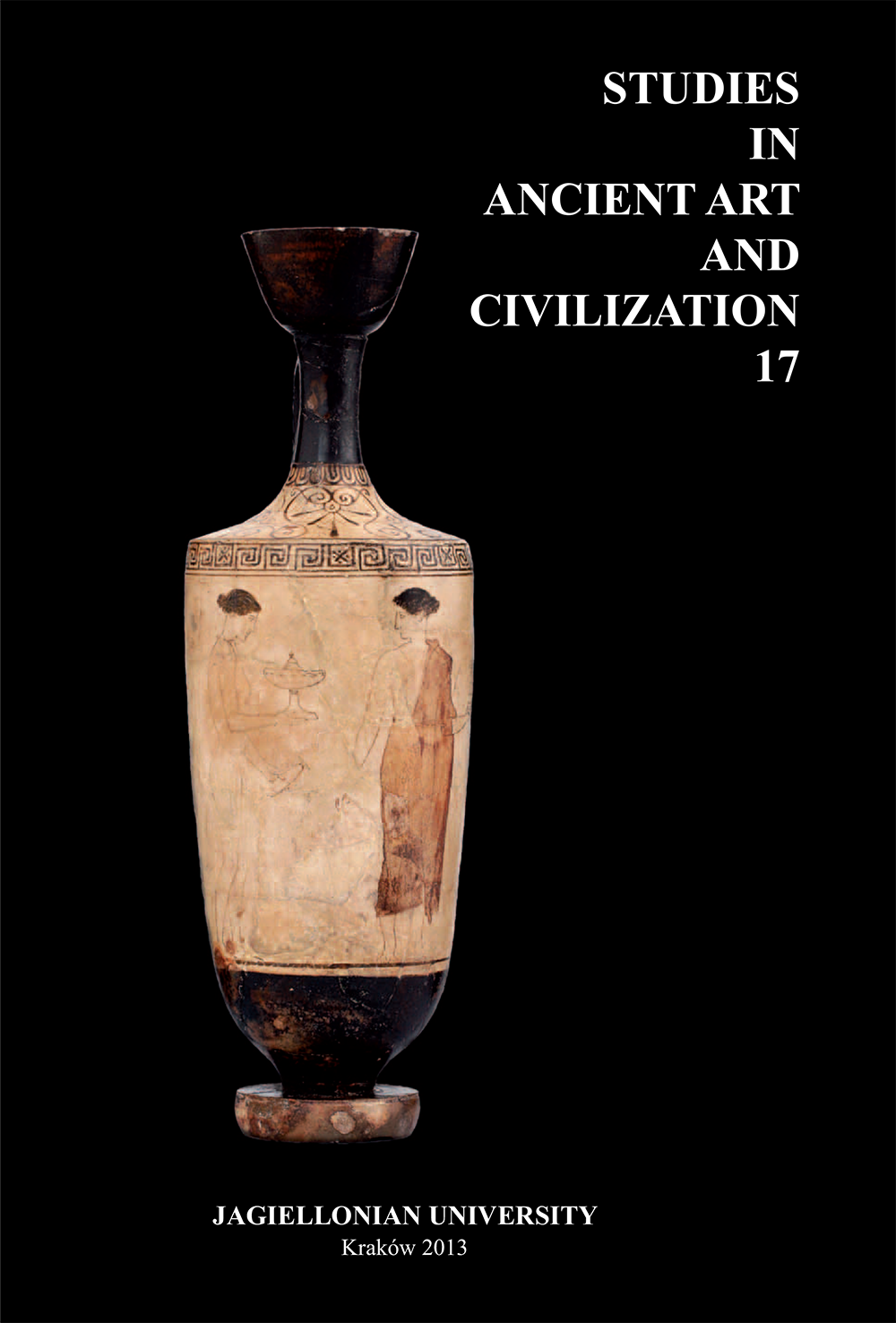Une nouvelle peinture funéraire de Paphos à décor symbolique
DOI:
https://doi.org/10.12797/SAAC.17.2013.17.23Keywords:
Cyprus, funerary chamber, Nea Paphos, painting, tombAbstract
The city of Nea Paphos is the only ancient city of Cyprus to have preserved much of the painted decoration of its buildings and tombs and the following paper aims to present a fresco that has recently come to light in one of the cemeteries of the city. The newly found painting was discovered on the right-hand side of the entranceway to the funerary chamber of a tomb of Hellenistic and Roman date and may be part of a larger decoration that has been destroyed. A human figure, possibly a young man, is depicted inside a frame created by branches bearing pomegranates. The figure is holding a fruit and is turned to his right, possibly towards another person. Behind him, an open mirror hangs from the wall over something that looks like a funerary monument. Although fragmentary, the scene depicts features that have a deeply symbolic meaning observed for the first time in Paphos. It presents an opportunity to examine new funerary iconography and discuss issues concerning afterlife beliefs in the ancient city.
References
Barruol G. 1985. Miroirs votifs découverts en Provence et dédiés à Séléné et à Aphrodite. RANarb 18, 343-373. DOI: https://doi.org/10.3406/ran.1985.1272
Bectarte H. 2006. Tenir un miroir dans l’art funéraire grec antique. In L. Bodiou, D. Frère, V. Mehl (éds), L’expression des corps. Gestes, attitudes, regards dans l’iconographie antique, 165-180. Rennes.
Cassimatis H. 1998a. Le miroir dans les représentations funéraires apuliennes. MÉFRA 110, 297-350. DOI: https://doi.org/10.3406/mefr.1998.2029
Cassimatis H. 1998b. Cosmétique et funéraire sur les vases apuliens. In S. Marchegay, M. Th. Le Dinahet, J.-F. Salles (éds), Nécropoles et pouvoir. Idéologies, politiques et interprétations, Actes du colloque Théories de la nécropole antique, Lyon 21-25 Janvier 1995, 155-166. Paris.
Charitōnidīs S. 1960 [1965]. Χαριτωνίδης Σ. Ι. Πήλινη γεωμετρική ροιά. ArchEph, 155-164.
Chavane M.-J. 1990. La nécropole d’Amathonte. Tombes 110-385. IV, Les petits objets. (Études chypriotes XII). Nicosia.
Davaras K. 1985. Δαβάρας Κ. Ρωμαϊκό νεκροταφείο Αγίου Νικολάου. ArchEph, 130-216.
Dunand M. 1965. Tombe peinte dans la champagne de Tyr. Syria 18, 5-51.
Grummond de N. 2002. Mirrors, marriage, and mysteries. JRA Suppl. 47, 63-85.
Grummond de N. 2009. On mutilated mirrors. In M. Gleba, H. Becker (éds), Votives, Places, and Rituals in Etruscan Religion. Studies in Honor of Jean MacIntosh Turfa, 171-182. Leiden. DOI: https://doi.org/10.1163/ej.9789004170452.i-292.73
Guimier-Sorbets A.-M., D. Michaelides 2009. Alexandrian influences on the architecture and decoration of the Hellenistic tombs of Cyprus. In D. Michaelides, V. Kassianidou, R. S. Merrillees (éds), Proceedings of the International Conference Egypt and Cyprus in Antiquity, Nicosia, 3-6 April 2003, 216-233. Nicosia.
Harrison E. 1964. Hesperides and Heroes: A Note on the Three-Figure Reliefs. Hesperia 33, 76-82. DOI: https://doi.org/10.2307/147030
Karageorghis V. 1973. Excavations in the Necropolis of Salamis III. Nicosia.
Markī E. 2005. Μαρκή Ε. Η απεικόνιση των οπωρών στην παλαιοχριστιανική τέχνη της Θεσσαλονίκης. Δελτίον της Χριστιανικής Αρχαιολογικής Εταιρίας Δ’ ΚΣΤ’, 85-92. DOI: https://doi.org/10.12681/dchae.430
Michaeli T. 1999. The wall-paintings of the Migdal Ashkelon tomb. ‘Atiqot 37, 211-223.
Michaelides D. 2004. Cypriot painted tombs and ceilings. In L. Bohry (éd.), Plafonds et voûtes à l’époque antique. Actes du VIIIe Colloque international de l’Association Internationale pour la Peinture Murale Antique (AIPMA), 15-19 mai 2001, Budapest, Veszprém, 89-96. Budapest.
Młynarczyk J. 1990. Nea Paphos III. Nea Paphos in the Hellenistic Period. Warsaw.
Nicolaou K. 1966. The Topography of Paphos. In Mélanges offerts à Kazimierz Michalowski, 561-601. Warsaw.
Oikonomou G. 1939. Οικονόμου Γ. Η επί της Ακροπόλεως λατρεία της Aθηνάς Νίκης. ΑrchΕph, 97-110.
Pōlogiōrgī M. 2007 [2008]. Πωλογιώργη Μ. Χάλκινα κάτοπτρα από τη Σαλαμίνα. ΑrchΕph 146, 148-192.
Raptou E. 2004. A painted tomb at Paphos (P.M. 3510). In Festschrift in Honour of J. Richard Green, 311-321. (Mediterranean Archaeology 17). Sydney.
Raptou E. 2006. The built tomb in Icarus street. RDAC, 317-343.
Raptou E. 2007. Painted tombs of Roman Paphos. Archaeologia Cypria V, 117-128.
Raptou E. 2011. Ράπτου Ε. Ο συμβολισμός στην ταφική ζωγραφική της ρωμαϊκής Πάφου. In Πρακτικά του Δ’ Διεθνούς Κυπρολογικού Συνεδρίου, Λευκωσία 29 Απρ. – 3 Μαΐου 2008, 251-266. Nicosia.
Sourvinou-Inwood C. 1978. Persephone and Aphrodite at Locri: a model for personality definitions in Greek religion. JHS 98, 101-121. DOI: https://doi.org/10.2307/630195
Vita di A. 1986-1987. Nea Paphos: necropoli del gruppo Omiros. Annuario LXIV-LXV, 526-530.
Wood-Conroy D. 2003. Roman wall paintings in the Paphos theater. RDAC, 275-300.






